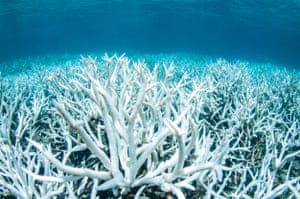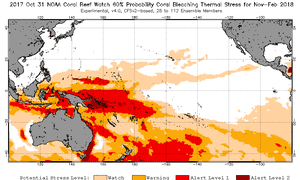
The coral bleaching events of 2016 and this year are said to have killed about half the Great Barrier Reef’s coral cover.
Photograph: Greenpeace/Reuters
More coral bleaching feared for Great Barrier Reef in coming months
The next event, if it occurs, may not be as damaging as the previous two, but could ruin the chances of coral recovery
The Great Barrier Reef could face more bleaching in the coming months, following unprecedented mass bleaching events in 2016 and 2017, which are believed to have killed half the coral.
Forecasts stretching to February are pushing the science to its limits, leaving significant uncertainty. But scientists say there is reason to be concerned, and some bleaching is very likely, although it won’t be anything like what happened during the past two years.

The most recent forecasts of the Coral Watch program of the US National Oceanographic and Atmospheric Administration (Noaa) puts much of the reef, especially the southern parts, on “Alert Level 1” in late February. At that level, bleaching is considered likely although it is not expected to continue long enough to cause much coral to die.
The head of Noaa’s Coral Watch program, Mark Eakin, said predicting the heat stress on the Great Barrier Reef in February was complicated because of the uncertain state of the El Niño/La Niña cycle.
“Unfortunately, that’s four months away and at the bitter end of our forecast skill,” Eakin said. “The farther away the forecast, the lower the skill. We don’t have an El Niño and the La Niña isn’t looking very strong. That lowers skill.”
He said there was reason to be concerned but not “too worried yet”.
“There will probably be some bleaching in some parts of the Great Barrier Reef but so far it doesn’t look anything like the last two years. However, it’s still early and we’ll know more in a month or so.”
Ove Hoegh-Guldberg, a leading coral bleaching researcher from the University of Queensland, said the results were concerning since, after the past two big bleaching events, a summer without heat stress would have given the coral the best chance of recovery.
“Ideally, it would be nice to have temperatures around average because then we might see recruits coming and corals growing back,” he said.
In 2016, the Great Barrier Reef suffered the worst bleaching event on record, with about 30% of the coral dying. At the start of 2017, it was hit again, losing roughly another 20%, leaving about half the coral cover dead.
The damage was worst in the top third of the reef, where some parts lost as much as 90% of their coral. The southern third of the reef mostly escaped any damage.
“We will be watching closely,” Hoegh-Guldberg said. “Most of us are holding our breath to a certain extent. Could this be the year in which we lose coral from the southern end of the Great Barrier Reef?”
The chance for a wave of coral recovery will emerge in the coming weeks as the famous spawning events begin. But for the worst-hit parts of the reef, that event would be hampered by the previous mortality, said Selina Ward, an expert from the University of Queensland, who has conducted studies into the impact of bleaching on coral reproduction.
“If you look at Lizard Island, which has been exposed to 2016 and 2017 heat events and suffered very high mortality, one of my colleagues has just been there and has not seen any reproductive colonies. And that’s where you would have expected most to be reproductive.”
For the badly-hit parts of the northern Great Barrier Reef, Ward said the spawning event was likely to be so adversely affected that they would be relying on coral spawning from the Coral Triangle to bring recruits through ocean currents.
Richard Leck, head of oceans at WWF-Australia, said conservation groups were also monitoring the bleaching warnings, and believed the forecasts were worrying. .
“The Noaa maps predict a better than even chance of coral bleaching in the southern Great Barrier Reef – the only part that hasn’t suffered widespread bleaching in the last two years,” he said. “It is a huge cause for concern that there is a chance the Reef is facing the threat of a third consecutive mass bleaching event.
“This is even more reason for Queensland to shift to a renewable energy future and away from old, polluting industries such as coal.”










